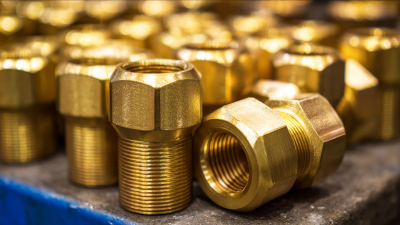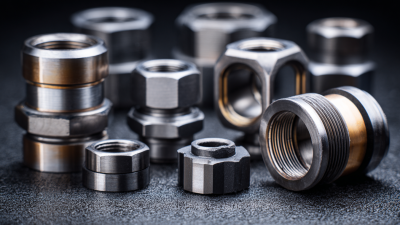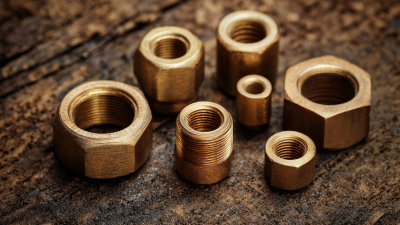Understanding the Unique Features of Ball Valve Types for Industrial Applications
In the realm of industrial applications, the choice of valve types is crucial for efficient fluid control, and ball valves have emerged as a preferred solution due to their unique features. According to a report by MarketsandMarkets, the global ball valve market is projected to reach $17.7 billion by 2025, driven by the increasing demand for reliable and leak-proof valves in various sectors, including oil and gas, water and wastewater management, and food and beverage. Ball valves are renowned for their straightforward design, allowing for quick operation and minimal pressure drop when fully open. Their durability and ability to handle high-pressure applications further enhance their appeal in industrial setups. This blog will explore the diverse types of ball valves, delve into their specific applications, and highlight the distinct characteristics that set them apart in the valve market.

Overview of Ball Valve Types and Their Applications
Ball valves are integral components in many industrial applications, prized for their reliability and efficiency in controlling fluid flow. According to a recent report by MarketsandMarkets, the global ball valve market is anticipated to reach USD 16.1 billion by 2026, fueled by the growing demand across various sectors, including oil and gas, water treatment, and pharmaceuticals. These sectors benefit from the high durability and minimal pressure drop characteristic of ball valves, making them ideal for applications involving high-temperature and high-pressure situations.
Different types of ball valves cater to specific operational needs. For instance, floating ball valves are often employed in low-pressure systems, while trunnion-mounted ball valves are suited for high-pressure applications, offering enhanced stability and reduced wear. A study published in the Journal of Industrial Valve Technology highlights that the use of trunnion-style valves can decrease operational costs by 15-20% in long-term projects due to reduced maintenance and improved reliability. As industries continue to evolve, understanding the unique features and applications of various ball valve types will be essential for optimizing efficiency and safety in fluid control systems.
Understanding the Unique Features of Ball Valve Types for Industrial Applications
Key Characteristics of Full-Bore vs. Reduced-Bore Ball Valves
When considering ball valves for industrial applications, understanding the differences between full-bore and reduced-bore designs is crucial. Full-bore ball valves provide a clear passage that matches the pipe diameter, enabling minimal flow resistance and energy loss. This is particularly advantageous in applications where fluid dynamics play a critical role, allowing for maximum flow capacity and efficiency.

On the other hand, reduced-bore ball valves feature a smaller internal diameter, designed to fit specific applications where space is a concern or where a significant reduction in flow is acceptable. These valves often exhibit a lower cost and lighter weight, making them a practical choice for lighter applications. However, it is important to note that the trade-off includes increased flow turbulence, which may not be suitable for all high-performance industrial scenarios.
Moreover, the landscape of valve technology is evolving with innovations like the three-position four-way water hydraulic directional valve, which leverages clean mediums like water instead of traditional hydraulic oils. As industries explore alternative solutions, the future of hydrogen valves also shows potential for significant advancements. Understanding the unique characteristics of ball valve types will help industries make informed choices as new technologies emerge and market trends shift.
Material Selection for Ball Valves in Industrial Environments
When selecting ball valves for industrial applications, material choice is crucial due to the diverse operating conditions they encounter. Various industries demand ball valves that can resist corrosion, high temperatures, and pressure fluctuations. According to a 2021 report by Market Research Future, the global industrial valve market is projected to reach USD 100 billion by 2026, emphasizing the importance of selecting the right materials that not only enhance durability but also operational efficiency.
Common materials used for ball valves include stainless steel, carbon steel, and various plastics. Stainless steel, particularly grades 304 and 316, is favored in chemical processing and oil & gas industries due to its superior resistance to corrosion and high-pressure capabilities. A study by the American Society of Mechanical Engineers (ASME) indicates that stainless steel valves have a service life that can exceed 20 years under proper maintenance. On the other hand, PVC and other polymers are preferred in pharmaceutical applications, where sanitation is paramount. These materials often meet FDA regulations, ensuring safety in sensitive environments. Therefore, understanding the specific material properties and their suitability for particular industrial applications is essential for optimizing performance and minimizing maintenance costs.
Understanding the Role of Seals and Seats in Ball Valve Performance
In industrial applications, the performance of ball valves is heavily influenced by the design and materials of seals and seats. Recent studies have highlighted the importance of these components in ensuring reliable operation, especially in demanding environments. For instance, research into the tribological behaviors of seat materials has led to the development of advanced tribometers that assess the wear characteristics and viscoelastic properties crucial for long-term performance under various conditions.

In particular, the analysis of a high-pressure hydrogen ball valve revealed that wear depth and volume during operation can significantly affect its sealing effectiveness and lifespan. Findings from a theoretical study indicate that the wear process can be quantitatively assessed, revealing that the material interactions between sealing substrates, such as pure PTFE and steel balls, play a critical role in valve integrity. Notably, variations in flow rates also impact transient temperature distribution within the valve, further emphasizing the need for precise engineering in sealing designs to maintain optimal performance across different operating scenarios.
Maintenance Tips for Ensuring Longevity of Ball Valves in Industry
Ball valves are favored in industrial applications due to their ability to provide a tight seal and quick shut-off capabilities. However, ensuring the longevity of these vital components relies heavily on proper maintenance practices. According to a report by the American Society of Mechanical Engineers (ASME), regular maintenance can extend the lifespan of ball valves by up to 30%. This highlights the importance of incorporating systematic inspection and upkeep into operational protocols.
One essential maintenance tip is to regularly inspect the valve seats and seals for wear and tear. Any deviations from the optimal condition can lead to leakage and compromised performance. Additionally, lubricating the valve stem can prevent corrosion and reduce operational torque, enhancing efficiency. The Chemical Pump Manufacturers Association (CPMA) suggests that weekly visual inspections, combined with annual maintenance checks, can significantly mitigate unexpected downtime and costly repairs.
Another crucial aspect is the environment in which the ball valves operate. High-temperature and high-pressure applications may require specialized materials or coatings to withstand harsh conditions. Utilizing valves that meet the relevant industry standards, such as those from the American National Standards Institute (ANSI), ensures compatibility and reliability. Implementing these tips allows industries to maximize the performance and lifespan of their ball valves, ultimately contributing to smoother operations and reduced maintenance costs.
Understanding the Unique Features of Ball Valve Types for Industrial Applications
| Ball Valve Type | Unique Features | Common Applications | Maintenance Tips |
|---|---|---|---|
| Standard Ball Valve | Simple design, low-pressure drop, reliable sealing | Water supply, gas distribution | Regular inspection of seals; lubrication of moving parts |
| Trunnion Ball Valve | Supports larger pipe sizes, reduced torque | Oil and gas, chemical processing | Periodic checking of mounting and seals; replace seals as needed |
| Floating Ball Valve | Ball floats to seal against the seat | Water treatment, HVAC systems | Inspect for leaks; clean and check seats regularly |
| V-Port Ball Valve | Control flow with tapered port; enhanced control characteristics | Process control, flow regulation | Routine calibration; check alignment and seating |
Related Posts
-

The Future of Innovation in Ball Valve Technology
-

7 Essential Tips for Sourcing High-Quality Brass Elbows in Today's Global Market
-

Discover Innovative Examples of Quick And Easy Fittings Solutions
-

The Future of Best Compression Fittings Revolutionizing Global Supply Chains
-

Discover Exceptional PPSU PEX Fittings from Leading Chinese Manufacturers for Global Procurement
-

Quick And Easy Fittings: A Data-Driven Comparison of Efficiency and Cost-Effectiveness in Modern Manufacturing
